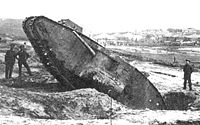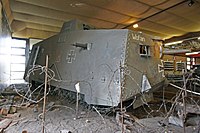Czołgi I wojny światowej
Poniższa tabela ukazuje zestawienie czołgów używanych w czasie I wojny światowej przez Wielką Brytanię, Francję oraz Niemcy.
Wielka Brytania
| Rok | Typ | Szt. | Widok | Uzbrojenie [zapas amunicji] | Pancerz (mm) | Szybkość maksymalna (km/h) | Załoga | Masa (t) | Moc silnika (KM) | Zasięg (km) | ||
|---|---|---|---|---|---|---|---|---|---|---|---|---|
| Przód | Bok | Góra | ||||||||||
| 1915 | Little Willie | Nieuzbrojony prototyp |  | 3 | 6 | |||||||
| 1916 | Mark I męski | 75 |  | 2x 57mm/L40 [324] + 3 ckm [6272] | 12 | 10 | 6 | 4,5 | 8 | 28,4 | 105 | 37 |
| Mark I żeński | 75 | 5 ckm [30080] | 27,4 | |||||||||
| 1917 | Mark II męski | 25 |  | 2x 57mm/L40 + 3 ckm | 12 | 10 | 6 | 8 | 45 | |||
| Mark II żeński | 25 | 5 ckm | 12 | 10 | 6 | 8 | ||||||
| Mark III męski | 25 |  | 2x 57mm/L40 + 3 ckm | 12 | 8 | |||||||
| Mark III żeński | 25 | 5 ckm | 12 | 8 | ||||||||
| Mark IV męski | 420 |  | 2x 57mm/L23 [332] + 4 ckm [6272] | 16 | 12 | 8 | 5,6 | 8 | 28,5 | 125 | 56 | |
| Mark IV żeński | 595 | 5-6 ckm [10000] | 27 | |||||||||
| Mark V męski | 200 |  | 2x 57mm/L23 [207] + 4 ckm [5800] | 14 | 14 | 8 | 7,5 | 8 | 29,5 | 150 | 72 | |
| Mark V żeński | 200 | 6 ckm [14100] | 28,5 | |||||||||
| 1918 | Mark V* męski | 200 | 4x 57mm/L23 [221] + 4 ckm [8400] | 12 | 6 | 4 | +24 | 33 | 63 | |||
| Mark V* żeński | 432 | 8 ckm [16800] | 4 | +24 | 32 | |||||||
| 1917 | Mark A "Whippet" | 200 |  | 4 ckm [5400] | 14 | 14 | 5 | 13 | 3 | 14 | 2x 45 | 64 |
Francja
| Rok | Szt. | Widok | Typ | Uzbrojenie [Liczba amunicji] | Pancerz (mm) | Szybkość maksymalna (km/h) | Załoga | Masa (t) | Moc silnika (KM) | Zasięg (km) | ||
|---|---|---|---|---|---|---|---|---|---|---|---|---|
| Przód | Bok | Góra | ||||||||||
| 1916 | 400 |  | Schneider C.A.1 | 75mm/L13 [94-96] + 2 ckm [4000] | 11,5 | 11,5 | 5,5 | 6 | 6 | 13,5 | 60 | 48 |
| 1917 | Schneider C.A.1 | 24 | 17 | 5,5 | 6 | 14,6 | 75 | |||||
| 1916 | 165 |  | St. Chamond M16 | 75mm/? [106-108] + 4 ckm [7488] | 11,5 | 8,5 | 5,5 | 8,5 | 9 | 22 | 90 | 60 |
| 1917 | 235 | St. Chamond M17 | 75mm/L36 [106-108] + 4 ckm [7488] | 11,5 | 17 | 24 | ||||||
| 3177 |  | Renault FT-17 z ckm | 1 ckm [4800] | 16 | 8 | 6 | 8 | 2 | 6,5 | 35 | 35 | |
| 1918 | Renault FT-17 z działem | 37mm/L20 [240] | 6,7 | |||||||||
Niemcy
| Rok | Szt. | Widok | Typ | Uzbrojenie [Liczba amunicji] | Pancerz (mm) | Szybkość maksymalna (km/h) | Załoga | Masa (t) | Moc silnika (KM) | Zasięg (km) | ||
|---|---|---|---|---|---|---|---|---|---|---|---|---|
| Przód | Bok | Góra | ||||||||||
| 1917 | 20 |  | A7V | 57mm/L26 [180]+ 6 ckm [10000-15000] | 30 | 20 | 15 | 12 | 18 | 32 | 2x 100 | 35 |
Projekty niezrealizowane
Wielka Brytania
| Rok | Szt. | Widok | Typ | Uzbrojenie [Liczba amunicji] | Pancerz (cale) / (mm) | Szybkość maksymalna (mile/h) / (km/h) | Załoga | Masa (t) | Moc silnika (KM) | Zasięg (km) | ||
|---|---|---|---|---|---|---|---|---|---|---|---|---|
| Przód | Bok | Góra | ||||||||||
| 1916 | 0 |  | Flying Elephant | Działo kal. 57 mm (6 funtów) / kal. 75 mm (13 funtów) + 2x ckm | 3 cale | 2 cale | 20 mm | 2 mile/h | ? | ~100 t | 105 KM | ? |
Niemcy
| Rok | Szt. | Widok | Typ | Uzbrojenie [Liczba amunicji] | Pancerz (cale) / (mm) | Szybkość maksymalna (mile/h) / (km/h) | Załoga | Masa (t) | Moc silnika (KM) | Zasięg (km) | ||
|---|---|---|---|---|---|---|---|---|---|---|---|---|
| Przód | Bok | Góra | ||||||||||
| 1918 | 2 |  | K-Wagen | 4x działa kal. 77 mm 7x karabin maszynowy Maxim kal. 7.92 mm | 30 mm | 30 mm | 30 mm | 7.5 km/h | 27 osób | 120 t | 650 KM | ? |
Zobacz też
- FCM F1
Bibliografia
- Reginald T. Townsend (grudzień 1916). "Tanks And The Hose Of Death". The World's Work: A History of Our Time: str. 195–207.
Linki zewnętrzne
Media użyte na tej stronie
Autor:
- 38254-new_folder-13.svg: http://www.kde-look.org/content/show.php?content=38254
- derivative work: Lampak (talk)
source of the original version: http://www.kde-look.org/content/show.php?content=38254
Compilation of footage of World War I era tanks. Opening title and footage of British rhomboid tanks taken from 1927 feature film The Somme. Brief footage of French Renault FT tank cut in after opening title. Possible that Renault tank is at Langres, but no conclusive evidence.
Model (1/48) of Flying Elephant tank prototype in the Bovington Tank Museum.
British Mark III tank in ditch, 1917.
Autor: baku13, Licencja: CC-BY-SA-3.0
Sturmpanzerwagen A7V Replik
American troops going forward to the battle line in the Forest of Argonne. France.
A larger, slightly cropped?, version of this image is available hereAn early model British Mark I "male" tank, named C-15, near Thiepval, 25 September 1916. The tank is probably in reserve for the Battle of Thiepval Ridge which began on 26 September. The tank is fitted with the wire "grenade shield" and steering tail, both features discarded in the next models.
Autor: unknown, Licencja: CC BY-SA 2.5
The Medium Mark A Whippet was a British tank of World War I. Intended to complement the slow Mark V tanks by using its relative mobility and speed in exploiting any break in the enemy lines.
Autor: Andrew Skudder, Licencja: CC BY-SA 2.0
The first ever tank, and you can see why they got that name as it does look like a big water tank on tracks.
Little Willie













